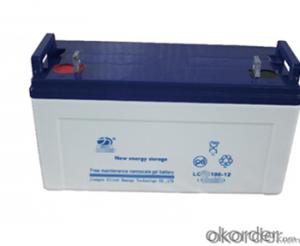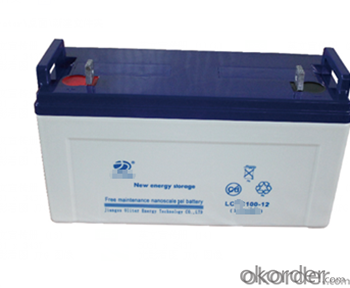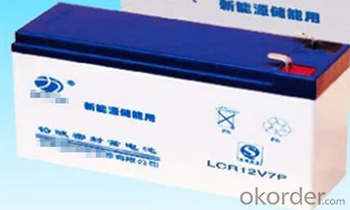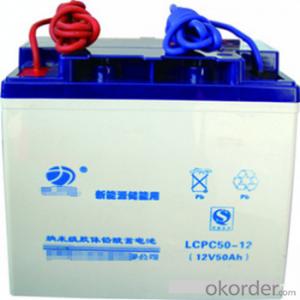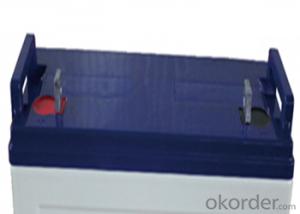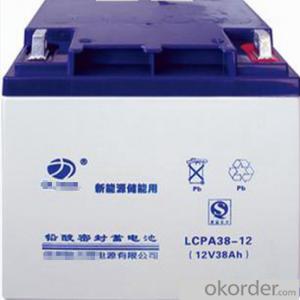Sensitized Solar Cells Emergency Battery LCR Series 12V
- Loading Port:
- China main port
- Payment Terms:
- TT OR LC
- Min Order Qty:
- 1 pc
- Supply Capability:
- 100000 pc/month
OKorder Service Pledge
OKorder Financial Service
You Might Also Like
Description
· Precision explosion relief valve shall be adopted
· Advanced wrapping technology and assembly technology
· Designed life is fifteen years,excellent performance of battery in low temperature and superiority in consistence and stability
· Balanced design for both floating and cyclic operation
· Connecting terminal adopts stainless steel bolt,thus it has the characteristics of high strength and non-deforming
· Design with patented corrosion resisting alloy and thickened plate
Application Area
Banks & Financial Centre
Hospital& Testing Laboratories
Power Generation Plants
High Power Backup Supply
Design with patented corrosion resisting alloy and thickened plate
Advantage
* Environmentally friendly : Products in the process of production and use, no leakage, no pollution, superior environmental performance, more matching with new energy products
*Low self discharge:Self-discharge rate of less than 3% per month, battery stamina: to adapt to the temperature range is wide, can deal with all kinds of bad use environment
*Stable quality&high reliability:Safety performance is reliable, the use of aluminum film packaging, by the authority test charge, discharge, short circuit, extrusion, acupuncture, drop, heating, such as performance, battery is not on fire, no explosion
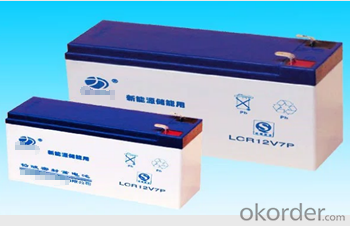
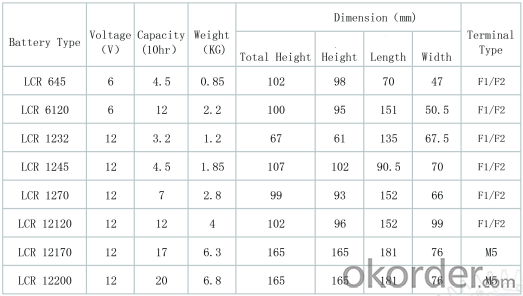
FAQ
*Can you tell me the parameter of your solar panels?
We have different series of cells with different power output, both from c-si to a-si. Please take our specification sheet for your reference.
* What’s price per watt?
It’s depends on the quantity, delivery date and payment terms of the order. We can talk further about the detail price issue. Our products is high quality with lower price level.
*What’s price per watt?
It’s depends on the quantity, delivery date and payment terms of the order. We can talk further about the detail price issue. Our products is high quality with lower price level.
- Q: What is a High-efficiency electric solar cell panel?
- A high-efficiency electric solar cell panel is considered to be lor cost, high result based on it's performance running under certain circumistance. In this case, I think it should be the crystalline solar panel.
- Q: How do solar cells perform in areas with high levels of air pollutants?
- Solar cells generally perform less efficiently in areas with high levels of air pollutants. Air pollutants, such as smog, dust, and particulate matter, can accumulate on the surface of solar panels, reducing their ability to absorb sunlight. This buildup of pollutants creates a barrier between the sun and the solar cells, decreasing their overall performance and energy production. Additionally, air pollutants can also block and scatter sunlight, further diminishing the amount of sunlight reaching the solar cells. Therefore, in areas with high levels of air pollutants, regular cleaning and maintenance of solar panels are necessary to ensure optimal performance.
- Q: How do solar cells handle high winds or hurricanes?
- Solar cells are designed to withstand high winds or hurricanes by being securely mounted to structures or rooftops. Additionally, they are built to be durable and have undergone rigorous testing to ensure that they can withstand extreme weather conditions.
- Q: Can solar cells be used for powering remote weather monitoring stations?
- Yes, solar cells can be used for powering remote weather monitoring stations. Solar cells, also known as photovoltaic cells, convert sunlight into electricity, which can be used to power various devices and systems. Remote weather monitoring stations often require a consistent and reliable source of power, especially in locations where access to the electrical grid is limited or non-existent. Solar cells provide a sustainable and environmentally-friendly solution for these stations by harnessing sunlight to generate electricity, ensuring continuous operation of the monitoring equipment.
- Q: Can solar cells be used in vehicles?
- Yes, solar cells can be used in vehicles. They are commonly used in electric vehicles (EVs) to charge the battery and provide power to various systems, increasing their range and efficiency. Solar panels can be installed on the roof or hood of a vehicle to capture sunlight and convert it into electricity, helping to reduce reliance on grid charging and decrease carbon emissions.
- Q: How do solar cells perform in areas with high levels of air humidity?
- Solar cells generally perform slightly less efficiently in areas with high levels of air humidity. This is because the water molecules in the air can scatter and absorb some of the incoming sunlight, reducing the amount of light that reaches the solar cells. However, the impact of humidity on solar cell performance is generally minimal and can be compensated by using anti-reflective coatings or cleaning the panels regularly.
- Q: Can solar cells be used to power electric vehicles?
- Yes, solar cells can be used to power electric vehicles. Solar panels can be installed on the vehicle's roof or other surfaces to capture sunlight and convert it into electricity. This electricity can then be stored in a battery pack and used to power the vehicle's electric motor. While solar energy alone may not be sufficient to fully power electric vehicles, it can supplement the battery's charge and extend its range, making it a sustainable and environmentally-friendly option.
- Q: How do solar cells perform in snowy conditions?
- Solar cells typically perform less efficiently in snowy conditions. The accumulation of snow on the surface of solar panels obstructs the incoming sunlight, reducing the amount of energy that can be converted into electricity. Additionally, the cold temperatures can also decrease the overall performance of solar cells. However, some modern solar panels are designed to be more snow-resistant and have special coatings that allow snow to slide off more easily, which helps to maintain their efficiency to some extent.
- Q: Can solar cells be used in desalination plants?
- Yes, solar cells can be used in desalination plants. Solar energy can be harnessed to power the desalination process, either directly or indirectly. Direct methods involve using solar panels to generate electricity to power the desalination process, while indirect methods involve using solar thermal energy to heat the water and drive the desalination process. Both methods have been successfully implemented in various desalination plants around the world, offering a sustainable and environmentally-friendly solution to produce fresh water.
- Q: Can solar cells be used in agricultural applications?
- Yes, solar cells can be used in agricultural applications. They can be used to power irrigation systems, provide electricity for farm equipment, and even to charge batteries for remote monitoring and control systems. Additionally, solar panels can be installed on agricultural buildings to generate renewable energy and reduce reliance on the grid.
Send your message to us
Sensitized Solar Cells Emergency Battery LCR Series 12V
- Loading Port:
- China main port
- Payment Terms:
- TT OR LC
- Min Order Qty:
- 1 pc
- Supply Capability:
- 100000 pc/month
OKorder Service Pledge
OKorder Financial Service
Similar products
Hot products
Hot Searches
Related keywords
